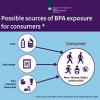Bisphenol A (BPA) is a chemical substance that is commonly present in products that contain certain types of plastics. Products may include construction materials, electronics, food and drink packaging, implants, intravenous equipment and toys. In addition, BPA is also used as a base for paint and adhesive products. BPA can also end up in surface water through wastewater from factories and households.
RIVM is conducting research into the safety of chemical substances, including BPA. In addition, RIVM is studying the safety of substances that can be used as alternatives to BPA. The organisation also advises ministerial departments on the safety of substances and how that safety can be investigated.
Lowering the health-based guidance value
New insights show that BPA may be harmful to human health at lower quantities than previously believed. This is why in 2023 the European Food Safety Authority (EFSA) lowered the health-based guidance value by a factor of 20,000 to a value of 0.2 ng per kilogram of body weight per day. This value establishes the amount of a substance a person can be exposed to without this having harmful effects on their health. The quantity of a substance that enters the body is referred to as the exposure.
The European Commission (EC) has taken various measures to reduce exposure to BPA. A number of changes to legislation, for example, led to a ban on the use of BPA in cash register receipts or baby bottles. Over the next few years, the use of BPA and some other bisphenols in food contact materials will be gradually reduced to zero. This means that food contact materials may still contain BPA for a number of years.
Alternatives to BPA in food contact materials
The use of BPA can be limited through the development of alternative substances that perform the same functions as BPA. However, it is crucial that any substitutes used are safe for human health. See the page on alternative substances for more information about this.
RIVM publications on BPA:
- Policy summary of public consultation regarding EFSA draft opinion on TDI for bisphenol A
- Bisphenol A: Part 1. Facts and figures on human and environmental health issues and regulatory perspectives | RIVM
- Bisphenol A: Part 2. Recommendations for risk management | RIVM
- Assessment of recent developmental immunotoxicity studies with bisphenol A in the context of the 2015 EFSA t-TDI - PubMed (nih.gov)
RIVM publications on alternatives to BPA:
- Biobased alternatives to hormone disrupting substance in cash register receipts | RIVM
- Substitution of bisphenol A: a review of the carcinogenicity, reproductive toxicity, and endocrine disruption potential of alternative substances
- A prioritization strategy for functional alternatives to bisphenol A in food contact materials
- Alternative food contact materials on the Dutch market after implementation of the Single Use Plastic Directive and prioritisation of potential migrating chemical substances | RIVM



